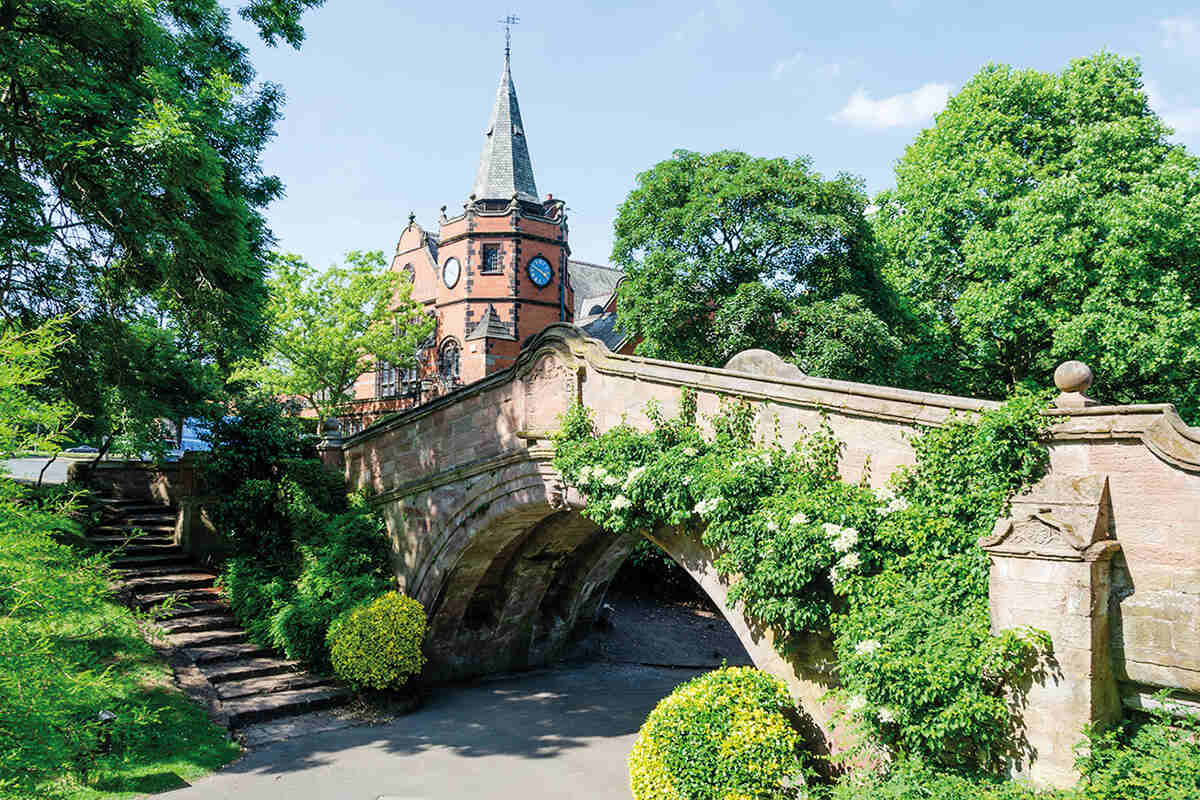
Rory Walsh explores the Merseyside village that soap built
Discovering Britain
Walk • Urban • North West England • Web Guide
A furtive pastime when travelling on suburban trains is peering into people’s back gardens. Glimpses appear of an otherwise hidden world: patios, conservatories, treehouses, trampolines. From the 1890s, passengers departing Liverpool for the Wirral saw something unusual. Past Bebington station, a long road lined with semi-detached houses ran parallel to the railway. Instead of turning away from the trains, they faced the line. Port Sunlight village stood proudly on display.
Port Sunlight was built for Victorian workers at the Lever Brothers soap factory. The village’s design, and wider concepts, were innovative and proved highly influential. Complementing the attractive houses were a variety of leisure and welfare amenities, including schools, shops, social clubs and a hospital. For Martin Haslett, creator of this walk, ‘Port Sunlight represents the pinnacle of British town planning.’
Haslett’s enthusiasm stems from professional and personal interests. ‘Port Sunlight was the brainchild of William Lever, a man with endless money and good taste who used them both to create an ideal village’ says Haslett. ‘I am a retired town planner. My career began at Liverpool University, where I studied in a planning department that William Lever had set up. This walk is my way of thanking him.’
The route starts at the entrance of the factory, Lever House. By the 1880s, Lever Brothers was a leading soap manufacturer. To meet increasing demand, the company moved from Warrington to this purpose-built factory on the east side of the Wirral. ‘The location was a masterstroke,’ Haslett says. ‘It provided access to the sea and an existing railway line. Crucially, it was also beyond the Port of Liverpool’s jurisdiction, so Lever avoided their fees.’
William Lever wasn’t only a shrewd businessman. He was a philanthropist who wanted his employees to have decent living conditions. He wrote, ‘There can be no reason why man should not make towns liveable and healthy [with the same] beneficial influence of bright sunshine, fresh air, flowers, and plants as the country.’ So, beside the new factory, Lever commissioned a workers’ village. Construction of Port Sunlight, named after the company’s most famous soap brand, began in 1888.
As we explore the village’s quiet streets, Haslett highlights various features among the houses. ‘Lever was passionate about architecture,’ he says. ‘He appointed leading architects and craftsmen. No expense was spared.’
The houses, referred to as cottages, were designed in groups to look like large mansions, albeit with multiple front doors. Each cottage had gardens, a modern kitchen and an indoor bathroom. The latter was a luxury at a time when many homes still had outdoor privies.

Alongside the housing, Port Sunlight’s layout was meticulously planned to take advantage of the natural landscape. At Park Road, we step onto an ornamental stone bridge. It spans the Dell, a scenic glade lined with benches. Haslett points out the curving streets on both sides.
‘The land Lever bought was flat and ready for building on,’ he explains. ‘It was also marshy and lined with tidal creeks that flowed into the Mersey. The Dell was created from a drained creek. The surrounding streets reveal its former course.’
The Dell is one of several open spaces throughout the village. Old maps show large allotments, designed to allow families to grow their own food. They now provide discreet car parking. While the allotments shrank, other areas grew. The bowling green expanded after a row of shops, the Employees’ Provident Stores, was destroyed during the Second World War and never replaced. ‘The stores were a co-operative, run by and for residents,’ reveals Haslett. ‘This was generous of Lever; he could have used the shops to supplement his own wealth.’
Discover more about Britain…
Most of Port Sunlight was funded by Lever’s business profits. He paid for two buildings personally. These were the Technical Institute, where employees took evening classes, and the church, where Lever was laid to rest. Haslett’s walk visits them both. We also pass the Port Sunlight Hotel. This was originally a cottage hospital. The bank, complete with its elaborate plaster mouldings, was once a library, while the village museum was a girls’ club. The garden centre occupies the former site of the open air swimming pool.
‘Everything you needed was here; housing, employment, health and leisure facilities,’ says Haslett. ‘Port Sunlight wasn’t a collection of pretty houses – it was a community.’ Lever’s community laid the foundations for decades of planning theory. The garden city movement and countless 1930s suburbs stem from Port Sunlight’s leafy cottages. ‘The legacy is enormous,’ says Haslett. ‘Port Sunlight influenced planning in Britain, and beyond, for almost a century, right up to the new towns like Stevenage and Milton Keynes.’
One absence in Port Sunlight was alcohol. Lever was teetotal and disapproved of drink. Therefore, Port Sunlight’s pub, The Bridge Inn, was ‘dry’. When a deputation of villagers asked if the inn could sell beer, Lever organised a referendum. After 80 per cent voted in favour, Lever granted their wish. ‘He was prepared to listen,’ reflects Haslett. ‘He also took active part in village life. He joined in with social activities, such as dances, and lived in Port Sunlight while his home was being renovated.’

To Haslett, ‘There’s a flattened hierarchy, with something socialist, almost Soviet, about it. For example, workers were allocated cottages by the size of their family rather than their role in the factory.’ In other ways, the village was highly paternalistic. Some recreational activities were compulsory. Only company employees could live in Port Sunlight until the 1980s. The residents were tenants, with rent deducted direct from their wages. Workers who lost their job also lost their home.
There were undoubted benefits to living and working in Port Sunlight. High-quality housing and factory conditions helped Lever’s employees live longer than the national average. By 1909, the infant mortality rate was half that in neighbouring Liverpool. Lever himself died in 1925. A memorial stands beside the Lady Lever Art Gallery. ‘Arguably the whole village is Lever’s memorial,’ suggests Haslett. The gallery is part of his legacy. Lever was an art lover and bestowed Port Sunlight his internationally important collection.
A spectacular view of the gallery concludes the walk. The final stop is at a mosaic that covers the village time capsule. It was installed by the Port Sunlight Village Trust, a charity that conserves and promotes the village. Port Sunlight is a conservation area, with more than 900 Grade II-listed buildings. Strict covenants direct today’s residents on how to maintain their homes, including house-by-house guidelines on what colour to paint the front door.
From the mosaic, long, straight roads lined with formal gardens draw our eyes towards the gallery entrance. This grand vista is one of Haslett’s favourite views in the village. ‘What I admire most about Port Sunlight is the beauty of it all, and how that beauty has been retained,’ he summarises. ‘The village was beautiful when it was built and is still beautiful today.’ To append the poet John Keats: A thing of beauty is a joy forever / Its loveliness increases / It will never pass into nothingness – if it’s well looked after.





